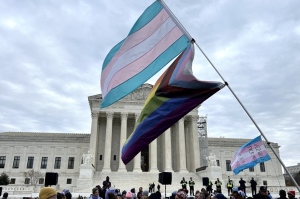Here's evangelicalism’s survival guide in this cultural gap

What we have today is an increasingly widening gap between cultural life and religious life. As the culture progressively loosens beyond mere secularization, religious communities are threatened to become vestiges of the past unless something is done.
As the gap grows, many who were brought up in religious communities are questioning, whether consciously or subconsciously, which wave they rather ride. Do they go toward the irreligious, postmodern, post-Christian culture? Or do they lean into the historical, traditional, and principled ways of Christian tradition?
Some, who are deaf to cognitive dissonance, seek to have both — religion on Sundays and culture the rest of the week. But as the divide has become so stark with foundationally different beliefs, these amalgamated forms of religion (e.g., “progressive Christianity,” syncretism, etc.) are less preferable to outright abandonment of religion (e.g., deconstruction). Thus, the battle today is not to retain a middle, lukewarm religious sentimentality. Rather, it is a battle for Christendom over against that which is seeking to usurp it.
With this phenomenon occurring so rapidly, leaders of evangelical church communities have largely failed to draw sufficient attention to the problem and offer mature and thoughtful yet firm stances and guidance through it. As a Christian myself, I can see an example of this failure in many churches across America. It is common to find hip pastors in trendy outfits going through a sermon series centered on the theme of a popular movie. These seek to stay relevant by incorporating cultural elements into church life.
Yet, in light of the present concern, we must now wonder if such tactics have been a sore miscalculation. By capitulating ever so slightly to culture as the gap widens, we may be witnessing the devastating result of a secularized and (God forbid) lost generation of evangelical Christians. And the statistics bear it out: Pew Research reported last year that self-identified Christians decreased from 75% to 63% of the population over the prior decade and the Cultural Research Center of Arizona Christian University released a report that only 37% of American pastors have a biblical worldview. 1, 2 Such realities are reminiscent of the late David Wilkerson’s harsh forewarning in which he saw “more of the world coming into the church and impacting the church rather than the church impacting the world.” Surely, we are finding true our Lord’s words that one ultimately cannot serve two masters.
It is no surprise, then, that there is a strong and consistent flow of young people toward traditional “high church” communities (Catholic, Anglican, Orthodox, etc.). A friend of mine (also in his twenties) who had also noticed this trend, particularly toward the Roman Catholic Church, labeled the phenomenon “reactionary Catholicism.” I think he is spot on in that assessment. It suggests such conversions may not be a matter of doctrine and theology. Rather, it is a matter of sincere Christian expression, living, and experience. If the church is only offering a “Christian” version of what the world offers, they truly offer nothing. (Speaking for myself, I’d much rather just listen to a secular musical artist than a Christian artist trying to sound secular.)
But, if the church is to offer me something countercultural, something timeless, a connection to the historic faith, a connection to Christians through the centuries, a reality that does not change based on the surrounding culture, then it has something of monumental value. Thus, for those who are growing ever more weary and dissatisfied with the grotesque and beastly creature our Western culture has morphed into, traditional Christian forms may be the necessary antidote, coming to us from a timeless past.
One of my seminary professors, Winfield Bevins, observed this movement towards liturgical church communities and recorded what he found in his book Ever Ancient, Ever New. In it, he explains:
While some are comfortable swimming in the uncertain waters of postmodernity with all of its relativity and flexibility, others have found those waters hazardous to their personal and spiritual health. These young people are searching for truths that transcend their immediate context. They long to be part of something lasting, and many have found that certainty in expressions of the Christian faith that embrace and acknowledge the full scope of church history – a Christian tradition that goes back two thousand years…. Young adults are longing for something to believe in and a story to be a part of, and for many, the liturgical tradition provides them with that sense of stability, a solid anchor amidst the uncertainty of their own struggles and the transitions of postmodern culture.3
As others have similarly understood this phenomenon, noting it is not some shallow or temporary trend but “a search for meaning that goes to the heart of our postmodern age.”4
Religion based on high liturgical forms is thus proving itself to truly be more valuable as the gap between culture and religion widens, not less. Yet large swaths of the American evangelical culture persist in operating under outdated notions, such as that the church must replicate culture if it is to stay relevant and valuable.
As evangelical churches have struggled to see the value they have in offering an abundant means to faith and flourishing, others from without have risen up to decry modern woes. In other words, American Christendom does not know how it seems to share its value (i.e., traditional religion) in a language properly spoken to youth and young adults. But others can speak that language. Or at least they are unafraid to try. This makes individuals such as Jordan Peterson extremely interesting. Branded a “gateway drug to Christianity,” he has been able to speak to modernity about the benefits of tradition in a more acceptable way.
And promoting “tradition” in the Western sense inevitably means promoting the Judeo-Christian values of yesteryear since American culture was formerly tied up with American Christian religious life. Touching on topics such as responsibility, suffering, virtue, masculinity, etc. he has won a wide audience (and, of course, many enemies). But given our postmodern context, Peterson does it in a way that embraces, rather than minimizes, the contrasts between tradition and modernity. Thus, his topics come to deal with not merely responsibility, suffering, virtue, and masculinity in general, but responsibility in the modern world, modern forms of suffering, traditional virtue over modern moral dissolution, and traditional masculinity in modern mixed environments, and so on.
The power of modern and postmodern forces in our essentially post-Christian society is having serious effects on not only moral and religious life but mental and social life as well. The present well-documented increases in mental illness, feelings of isolation and loneliness, anxiety, and depression – especially among younger populations – are suggestive of how dire the situation really is. Not to mention the successful attack upon the nuclear family and the mental and social issues continually springing from that front. It all reminds us just how necessary traditional religious norms previously were for the standard social health our society once enjoyed.
As these negative forces crept up throughout the 20th century starting with the roaring twenties, maturing in the sexual revolution of the sixties, and waging an all-out war today, many fervently spoke against such forces from the Christian position. We once had G.K. Chesterton, C.S. Lewis, Francis Schaeffer, and others who openly denounced the ways of encroaching modernism – men who were perhaps not mere sentimental defenders of days gone by but rather much more akin to actual prophets. Perhaps their rants were truly warnings – warnings for which we are now reaping the injuries of ignoring.
This naturally leads serious Christians today to ask, “who will replace them?” The church does not seem to speak with a unified voice on the matter, if with any voice at all. Surely, it is not able to. There are divisions growing right within American Christendom itself. And no denomination appears exempt from such present conflicts. Thus, the problem of the American church struggling to figure out how to remain relevant – does it adapt to modernity or stand firm upon tradition?
And that is my point for this entire piece. I am hoping to show that the church is not in need of anything new. God knows we’ve tried that long enough. No, the fun and the new will not do. Forcing artificial “revivals” with smoke and lights, making sermons cool by borrowing notes from Hollywood, hosting youth events with mostly games and food with a short sermon tagged on at the end, and giving inspirational Christian Ted talks will continue to fail as they have only done. They will not create a lasting and thriving impact on the faith life of the young. Rather, perhaps Evangelicalism in America can take a different approach. Perhaps Evangelicals, rather than minimize their religiosity as if ashamed of any hint of order and structure and, dare I say it, rules, can instead embrace tradition, embrace religion, and embrace their long Christian heritage with all its rules, systems, and prescriptions for living.
As the church has shied from this great calling, others will continue to fill the void. We have seen how those already within evangelicalism are leaving for the traditional high churches. But for those outside the church – those secular young people who desire to disassociate with the empty culture and refuse its dissatisfying offerings – they will be inclined to turn to the only voices they find that offer firm, grounded, thoughtful, articulate, and unabashed traditional norms. And, sadly enough, it is not found in evangelical churches. And lest these young people latch onto the nonreligious, semi-deist notions of the Jordan Petersons of the world, the evangelical church must offer firm and bold voices to defend tradition, now more than ever.
If you are a leader in the evangelical world, look and read the cultural landscape around you and take a note or two from the rich book of Christian tradition. That may look different depending on what your church community is already doing and what they already believe and practice. But incorporating more traditional values, liturgical forms, and religious standards into our already missional-minded evangelical Christianity will only serve to strengthen our message’s desirability. It need not scare us. We can remain Bible-focused while simultaneously offering tradition to the decaying modern world. After all, that biblicism is an important part of what makes evangelicals evangelical! So, let’s evangelize our culture not only with the message of “Jesus loves you” but also with “here is how He says to live.” Let’s once again offer a sluggish world the beauty of duty, discipline, structure, rules, holiness, and virtue. In a word, let’s offer tradition. In doing so we may bring the light of heaven to a dark and dismal world.
1. Gregory A. Smith, “About Three-in-Ten U.S. Adults Are Now Religiously Unaffiliated,” Pew Research Center, December 14, 2021. https://www.pewresearch.org/religion/2021/12/14/about-three-in-ten-u-s-adults-are-now-religiously-unaffiliated/
2. George Barna, “Release #5: Shocking Results Concerning the Worldview of Christian Pastors,” Cultural Research Center at Arizona Christian University, American Worldview Inventory 2022, May 10, 2022. https://www.arizonachristian.edu/wp-content/uploads/2022/05/AWVI2022_Release05_Digital.pdf
3. Winfield Bevins, Ever Ancient, Ever New: The Allure of Liturgy for a New Generation, (Grand Rapids: Zondervan, 2019), 69-70,
4. Gracy Olmstead, “Why Millennials Long for Liturgy: Is the High Church the Christianity of the future?” The American Conservative, January 14, 2014. https://www.theamericanconservative.com/why-millennials-long-for-liturgy/
Michael Giammarino graduated from Oral Roberts University and is continuing his theological studies at Asbury Theological Seminary. He is the author of the book Discovering Justice and is working on a second book, A Mighty Wind, which examines the 2,000-year history of the miraculous and supernatural tradition within Christianity.




























